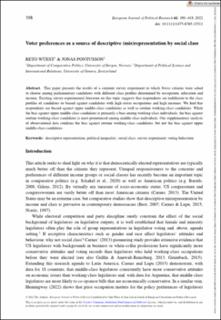| dc.contributor.author | Wüest, Reto | |
| dc.contributor.author | Pontusson, Jonas | |
| dc.date.accessioned | 2023-03-01T14:00:05Z | |
| dc.date.available | 2023-03-01T14:00:05Z | |
| dc.date.created | 2022-04-08T09:43:57Z | |
| dc.date.issued | 2022 | |
| dc.identifier.issn | 0304-4130 | |
| dc.identifier.uri | https://hdl.handle.net/11250/3055062 | |
| dc.description.abstract | This paper presents the results of a conjoint survey experiment in which Swiss citizens were asked to choose among parliamentary candidates with different class profiles determined by occupation, education and income. Existing survey-experimental literature on this topic suggests that respondents are indifferent to the class profiles of candidates or biased against candidates with high-status occupations and high incomes. We find that respondents are biased against upper middle-class candidates as well as routine working-class candidates. While the bias against upper middle-class candidates is primarily a bias among working-class individuals, the bias against routine working-class candidates is most pronounced among middle-class individuals. Our supplementary analysis of observational data confirms the bias against routine working-class candidates, but not the bias against upper middle-class candidates. | en_US |
| dc.language.iso | eng | en_US |
| dc.publisher | Wiley | en_US |
| dc.rights | Attribution-NonCommercial-NoDerivatives 4.0 Internasjonal | * |
| dc.rights.uri | http://creativecommons.org/licenses/by-nc-nd/4.0/deed.no | * |
| dc.title | Voter preferences as a source of descriptive (mis)representation by social class | en_US |
| dc.type | Journal article | en_US |
| dc.type | Peer reviewed | en_US |
| dc.description.version | publishedVersion | en_US |
| dc.rights.holder | Copyright 2022 The Author(s) | en_US |
| cristin.ispublished | true | |
| cristin.fulltext | original | |
| cristin.qualitycode | 2 | |
| dc.identifier.doi | 10.1111/1475-6765.12511 | |
| dc.identifier.cristin | 2016104 | |
| dc.source.journal | European Journal of Political Research | en_US |
| dc.source.pagenumber | 398-419 | en_US |
| dc.relation.project | ERC-European Research Council: grant agreement no. 741538 | en_US |
| dc.identifier.citation | European Journal of Political Research. 2022, 61 (2), 398-419. | en_US |
| dc.source.volume | 61 | en_US |
| dc.source.issue | 2 | en_US |

